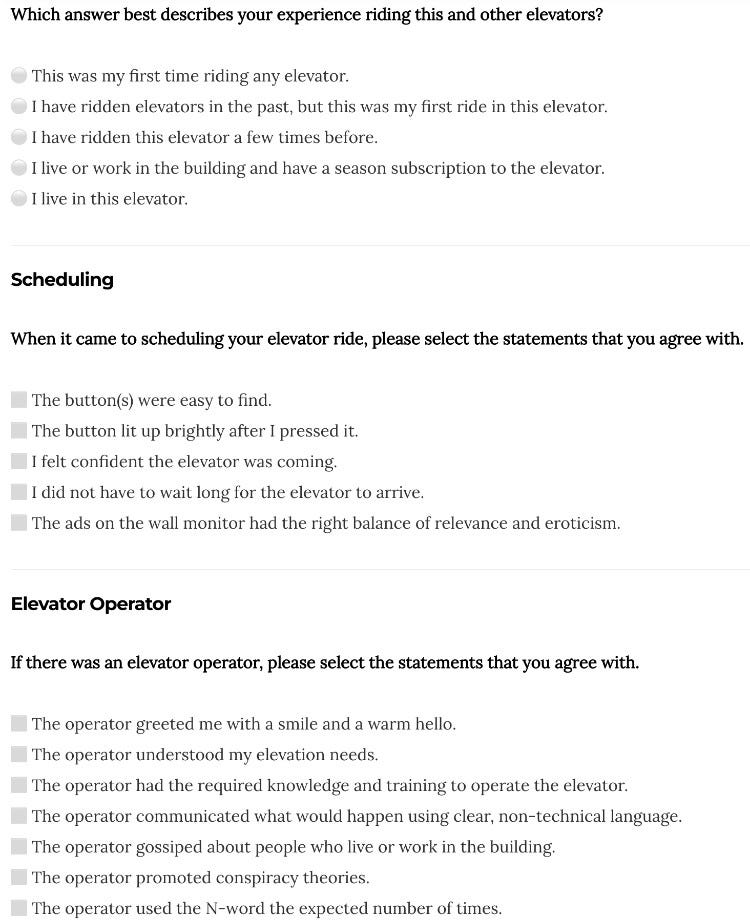Komedy Klass: Let the Universe Do the Hard Work
Original comedy doesn't need to be 100 percent original
Here’s the most important thing to know about comedy audiences: They are drooling, braindead triple-retards. They’re ten times dumber than the dumbest person you’d ever want to meet, and they come to comedy clubs and make themselves dumber still with alcohol. They are ignorant, foul-smelling cellular blobs who shouldn’t be able to drive, vote, or reproduce, and if I had one wish, it would be for them to be impaled on a giant railroad spike.
Not you, though. Other comedy audience people.
But seriously: Comedians sometimes ask too much of the audience. We make it hard to get the joke by giving the audience/reader too much to figure out. Here’s a clip from a recent episode of The Lonely Island and Seth Meyers Podcast about a comedian pitching a joke that gave the audience way, way too much work to do. Comedy writer Tim Kalpakis tells the story of another writer pitching a joke for Andy Samberg at the 2009 MTV Movie Awards:
The idea that the audience would quickly realize that “Land of the Lost” is only a few letters away from “Hand of the Host” — and then backfill that information to understand Andy’s reaction — is so ridiculous that it completely deserves to be talked about on a podcast 16 years later. (Note: No judgement — pitch sessions are a quantity-over-quality business, and I have pitched thousands of jokes millions of times worse than that.) Remember: The audience is lucky to have dressed themselves and made it outside, most of them are confused by lights and gravity, expecting them to process anything more complex than “that dude farted” is a fool’s errand.
So: What’s the opposite of a joke with “too much math”?1 The opposite is to start with something that the audience recognizes, and then tweak it.
If it sounds like I’m judging this trick — if there’s any part of you that thinks that I’m sneering at the concept of parodying an existing thing instead of creating something from scratch — let me be clear that I’m not. I’m praising this move: Comedy built from something people recognize does the hard work so that the audience can focus on the joke. Jokes that depend on the audience to fill in too many gaps are the jokes that are lazy. A well-designed joke is like a well-designed computer or smartphone, in that even The Dumbest Motherfucker In The Galaxy should be able to enjoy it.
A great example of parodying something people recognize is today’s Komedy Klass example, which comes from reader (and Substack author!) Rob Block. Rob’s piece is called “Please Complete This Brief Survey About Your Recent Elevator Ride”, and it takes the form of those “how did we do?” surveys that are everywhere these days. I loved this piece because the premise was rock-solid — we get these surveys for everything now — and the details were spot-on. I encourage you to read the whole thing (for free) here, but in the interest of this not becoming an essay within an essay, let me pick out some highlights:
As you can see, Rob’s fake survey perfectly matches the style and tone of the real thing. That’s crucial; it makes the parody more recognizable and relatable. The antiseptic corporate tone of these surveys is half of the humor, and the absurd fill-ins seem more absurd when the trappings are stone cold sober. When parodying something, drawing as many details as possible from the actual thing helps you get as much juice as you can from the premise.
When you make fun of something that people recognize, you’re likely to get buy-in. If you can act fast on relatively new thing that everyone knows — like these surveys, which are suddenly everywhere — you have a chance of hitting that “thing-people-noticed-but-haven’t-seen-much-comedy-about” sweet spot. Plus, because the reader gets the joke, they get to feel a little smart, which might be one of the few times that happens in their annoying little lives.
Also: Publications love these. If you’re submitting to The New Yorker, McSweeny’s, or The Shaved MILF Literary Review, your piece will stand out if it’s a fake survey, test, instruction manual, advertisement, letter, text chain, web site, children’s book, or something else. There are just so many essays out there — these publishers are up to their shaved MILF pubic zones in essays. Doing a parody instead of a straight-up essay breaks up the monotony and helps your piece stand out. Also, these pieces usually require less reading, and no matter how much the holier-than-thou dweebs at The New Yorker pretend otherwise, reading is the Stairmaster for your brain and doing it for too long hurts.
I use the fake-parody-thing format whenever possible. Here’s a fake elementary school test, here’s a fake letter of resignation, here’s a fake letter to shareholders, here are fake tweets and still more of them, here’s a fake text chain, and here’s yet another. One of my longest-running bits is Paula Fox, the award-winning investigative journalist who just happens to write in the voice of a Russian spam-bot, and few things are more recognizable these days than e-mail spam. Cribbing the format of an existing thing draws the reader in, adds some fun, flashes a little production value, and it’s usually compatible with another comedy principle: Use fewer words.
So: When you have an idea that involves altering an existing thing instead of writing an essay from scratch, I’d upvote that idea. Make things easy for the audience; get the ball to the one yard line by making your topic something that they recognize, and then let them score the touchdown and celebrate like some stupid Make A Wish kid. Asking people to process something wholly original can be asking too much. Remember: These are drooling, pinheaded, embarrassing freaks that you’re trying to please, and you can help yourself by making your comedy about one of the four things that they already know.
Komedy Klass: The Power of Visuals
When I was young and a much more acute form of douchebag, I considered everything in comedy other than calmly reciting jokes to be a “cheat”. Guitars? That’s a cheat. Impressions? A cheat. Being engaging and charismatic? Perhaps the biggest cheat of all. I was a co…
Komedy Klass: What -- Or Better Yet WHY -- is Satire?
***This is the second edition of IMBW Komedy Klass! You can always send your stuff to KomedyKlass@imightbewrong.org — every time we do this, I pick one piece to serve as a focal point.
“Math” is the word comedians use to mean “the audience needs to piece things together in order to get the joke.” It doesn’t have to be literal math.






No deep thoughts here, but that survey was genuinely hilarious.
I think another valuable aspect here is: once you've got your audience on the same page with a familiar concept, you can start veer off the beaten path.
Take the elevator operator section: it starts with what you'd expect from an elevator operator (friendliness, understanding), only then does it get a little off (gossip), and only THEN does it get to how many N-words are they using.
If the first question was "are they using the right number of slurs", you'd lose a lot of people. You have to get them to trust you enough to hold your hand before you can pull them off the road.